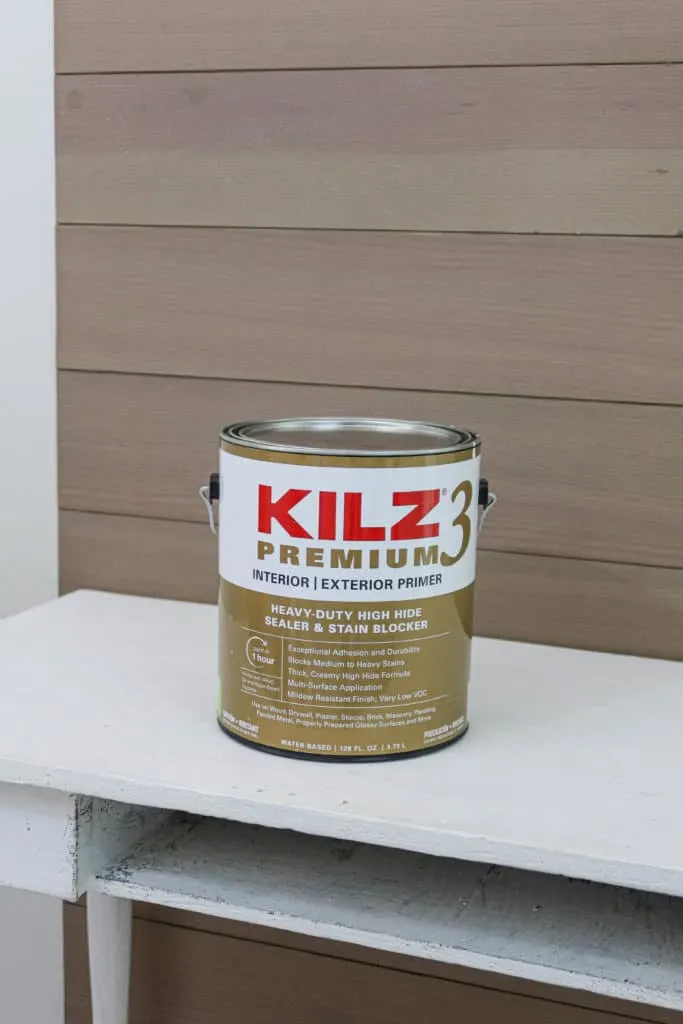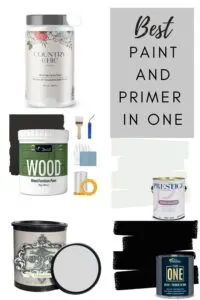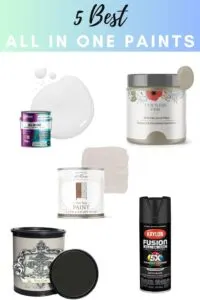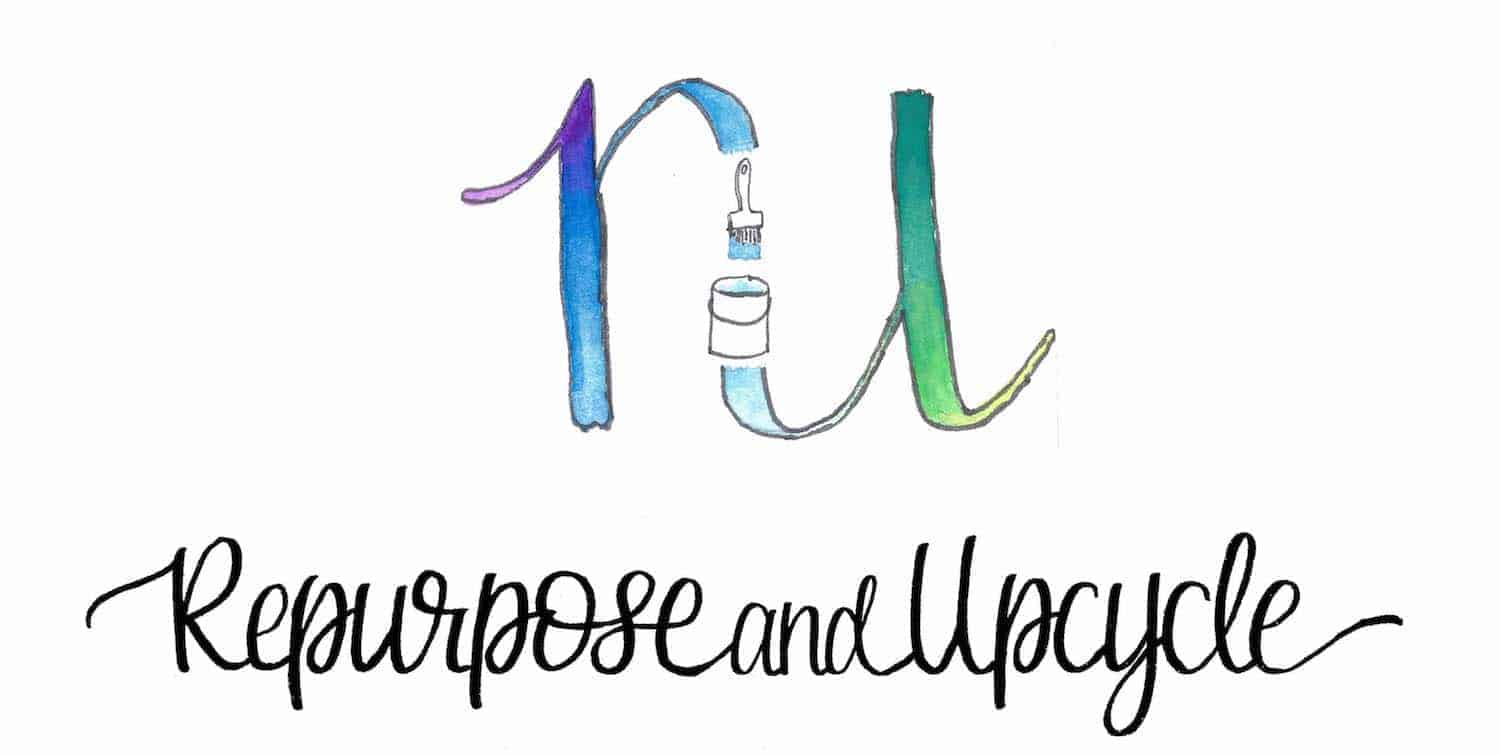Learn about why you need to prime furniture with a detailed list of all the different types of primer.
Primer; do you need to use it before painting furniture? This is the question I didn’t ask myself when I first started painting furniture and I paid the price. I assumed that you didn’t need to prime furniture when using paints like chalk paint and milk paint. I was wrong. I’m always the first to say “let me make the mistakes so you don’t.” This is a humbling post because I’ve made this mistake a lot and I’m going to share why you need to prime furniture before painting.
Disclosure; this post contains affiliate links. As an Amazon Associate I earn from qualifying purchases. This does not affect the price you pay. This disclosure statement refers to the rest of the Amazon links in this post. See more on my disclosure page.
Table of Contents
To Prime furniture or NOT to prime furniture- that is the question
I just recently re painted a TV stand for hopefully the last time. When I repainted it I told myself I was going to do it right this time…with primer.
When I initially gave this TV stand a milk paint makeover, I thought “milk paint sticks to everything and doesn’t need any prep work so primer isn’t necessary.”
Here’s the problem with that statement. Primer is used for so much more than allowing the under coat of paint to stick to the new paint. Primer seals that paint underneath so over time it won’t “bleed through” to the new paint.
So now that you know this, can you answer the question below?

Do you need to use a primer for furniture before using chalk paint or milk paint?
Absolutely. We all know that chalk paint and milk paint are known for “no prep” and being able to stick to any surface without sanding. That being said, primer is used for so much more than allowing the first coat of paint to stick to a new coat of paint. You also need to make sure to seal the first coat of paint (you even need to seal the tannins or wet spots on raw wood) so years down the road that new coat of paint won’t blend with the old coat. This is known as “bleed through” in the furniture painting world. Also, some primers can even hide old smells!
What about painting unfinished wood without primer?
Just because a piece of furniture hasn’t been painted doesn’t mean something (like tannins or previous wet spots) won’t bleed through the new coat of paint at some point. It’s always a good idea to use a primer, especially if it’s an older piece of furniture.
Can primer be used by itself as a top coat of paint?
Nope. Although if you’ve tried it, you might say it works just fine, but primer wasn’t intended to be used as a top coat and isn’t formulated to survive all the elements. I’ve shared all the details to this question in a post detailing if primer can be used as a finish coat of paint.
Furniture Primers for Every Project
There isn’t a right or wrong answer for this. This is mainly personal preference. That being said, there are a few things you need to know before you choose a primer. If you want a list of some of the top rated primers, check out the best primer for furniture here. If you plan to paint your cabinets anytime soon, also make sure to check out our five best primer for cabinets post!
Furniture painting how to; How to choose the right type of primer for furniture
There are three main types of primers; oil based primers, latex based primers (water based), and shellac based primers. Just keep in mind a few things;
- If you are going to use an oil based paint over a water based paint, make sure to use a water based primer first (shellac or latex).
- If you are going to use a water based paint over oil based paint, you can use oil or water based primer.
If you don’t know what type of paint has been previously used on your piece of furniture, you can do a simple test that I shared from my post on how to choose the right type of paint.
Pour a bit of acetone (nail polish remover) on a rag and wipe the surface with it. If the old paint rubs off on the rag then it’s latex or water based. If it doesn’t wipe off then it’s oil based.
Oil based primers
Oil based primers tend to be the gold standard in furniture painting due to their durability. They are known for their stain and odor blocking ability. That being said, they take more time to dry, release more VOC’s (volatile organic compounds), and require paint thinner for cleanup. They are a little more susceptible to peeling and cracking than water based primers.
Latex based primers (water based)
Latex based primers are more versatile in that they can cover more materials than oil based primers like metal, brick and wood. Latex primers are becoming increasingly more popular in the furniture painting world because they have low VOC’s, dry fast and make clean up easy with just water.
Shellac based primers
Shellac based primers are very effective at sealing wood from water damage and odors. Unlike Oil based primers, they are fast drying and can be used on metal and plastic. The downside with this type of primer is the high level of VOC’s and fumes. Cleanup requires denatured alcohol.
After sharing some facts about primers, I’ll share some of my thoughts.
A few of my favorite primers
My favorite type of primer is honestly the Rust-Oleum Bullseye primer. It’s great at sealing wood, it’s fast drying and it has low VOC’s. I do a lot of painting inside and I have to be careful with fumes. I’ve covered countless pieces of furniture with this primer and it’s held up well. It’s also easy to use in a paint sprayer.
I’m also a big fan of the KILZ premium primer. It’s formulated to cover stains and hide odors as well. The KILZ Adhesion high bonding primer is also a good one if you are painting laminate cabinets or painting IKEA furniture.

You can see I’m a fan of latex and water based primers.
Now that you’ve seen why you need to use a primer, I often get asked one more question;
How many coats of primer on wood is necessary?
Before deciding on how many coats of primer need to be used, you need to evaluate the surface you are painting.
Is it unfinished or previously painted? If it’s unfinished wood, you will likely need more than one coat of primer because most unfinished wood is very porous and will soak that primer right up!
If the wood has been previously painted and is similar in hue to your new paint color, you can probably get away with one coat of primer.
If the wood has been previously painted and is much darker than the new paint color, you probably need two coats of primer. This creates a good color barrier between the old paint and the new paint.
If the wood has been previously stained, two coats of primer is key because you don’t want the old dyes from the stain to seep through the new paint color (this is called bleed through).
What about the All-in-One paints or Paint plus Primer products?
There are loads of paint plus primer products and even primer plus paint plus a top coat in one! So why bother with using separate products when you can paint it all at once?
Simply put, every surface is different and every project will need to be assessed differently. In my opinion, high traffic surfaces need their own separate primer coat.
Just remember, the all-in-one products may not provide the same level of coverage or adhesion as a separate primer and paint, especially on surfaces that are in poor condition or have been previously painted with a different type of paint.
For those looking to reduce the painting time with an All-in-One paint or Paint and Primer in one, I’ve got you covered with some of my favorite products.


I hope I’ve shed some light on how to prime before painting furniture. Don’t make the same mistakes I have made friends. There are very few instances where primer isn’t necessary when painting furniture. As a matter of fact, it can’t hurt to use primer so why not!
Let’s get to painting (but remember to primer first)!
Lindsey**

This is the best info I have read on furniture prep. No guessing. All my questions have been answered. Thank You so much
Great! I’m so glad to be of help!
Thank you, Lindsay! I have four extra heavy/tough chairs from Boston Market restaurants. I was not looking forward to sanding them before painting and stenciling.
You Welcome!
Thank You Lindsey for all the info on primers and painting. As a fairly new DIYer, I really appreciate the time and effort you put into this. I will read all the other articles on painting and save them for future use. Stay Safe.